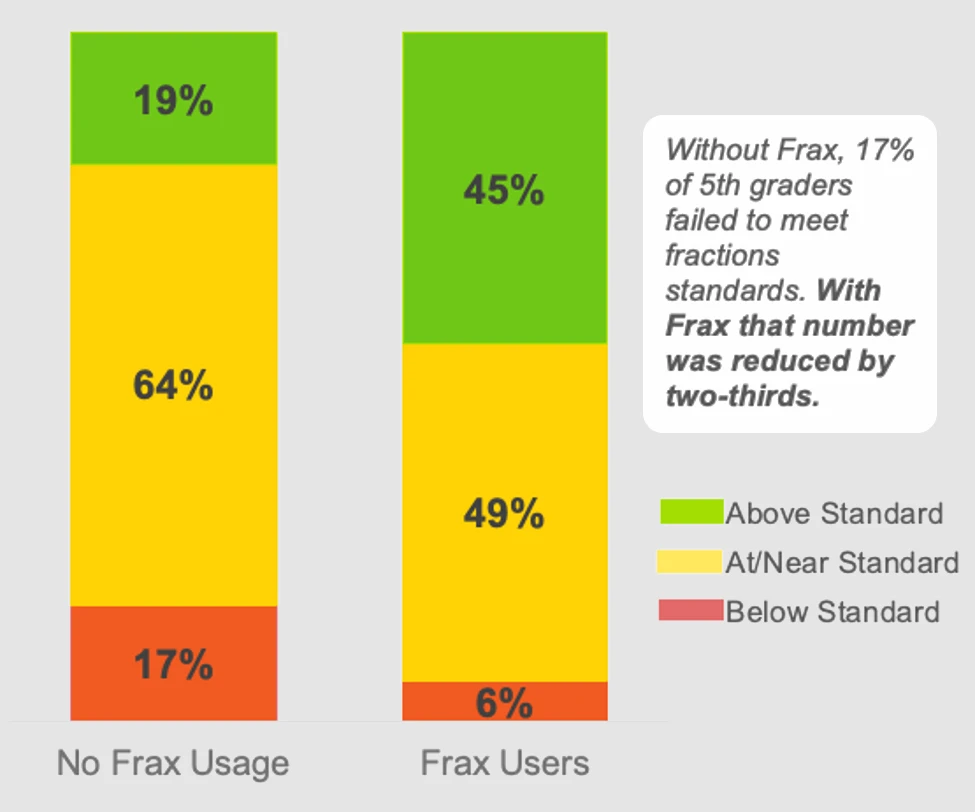
ExploreLearning has partnered with a large school district in Florida since 2021 to measure the impact of ExploreLearning Frax—an adaptive, game-based program that helps students build mastery of fractions—on students’ fractions knowledge and overall math achievement.
After three years, a new longitudinal study highlights the profound impact of Frax, demonstrating how early and consistent classroom use leads to lasting fractions proficiency for students, building the foundation for success in algebra and higher-level math.
Three-year longitudinal study reveals transformative fractions gains
The Florida school district partnered with ExploreLearning to better understand whether Frax was supporting their students’ math learning. Working closely with district leaders, the ExploreLearning research team helped analyze student performance data to uncover the impact of consistent Frax usage and highlight areas where students were excelling. Together, teams used these insights to inform decisions about when and how to implement Frax most effectively, ensuring that the program was tailored to meet the district’s goals for student success.
Students who used Frax in Year 1 showed statistically significant improvements in math achievement, even among the most academically at-risk learners, with gains continuing into Year 2. The most recent Year 3 analysis confirms that Frax isn’t just a short-term boost—students who used Frax in 3rd and 4th grade carried those benefits forward, outperforming peers in fractions and overall math achievement well into 5th and 6th grade.
Year 1: Frax is 5x more impactful than the average intervention
The first year of the study compared 2,520 grade 3 and 4 students who used Frax during the 2021-2022 school year to a statistically matched sample of non-users. In Year 1 of implementation, Frax proved to be five times more effective than the average math intervention.
Students who consistently completed Frax missions demonstrated significant growth in fractions knowledge, building a stronger foundation for future math learning compared to their peers.
Year 2: Sustained success and rapid catch-up for new users
The second year of the study revealed two important findings: students who started Frax in Year 1 sustained their fractions growth, while students who were new to Frax rapidly caught up, closing learning gaps faster than expected. Students in grades 4 and 5 who used Frax in Year 2 showed achievement gains, fully catching up to or exceeding their peers and closing any achievement gaps observed in Year 1.
Year 3: Long-term impacts on math success
By the third year, Frax’s influence extended beyond fractions understanding to broader math performance. Students who built early proficiency with Frax carried those skills forward into more advanced math, including ratios, proportions, and algebraic reasoning.
In the third year of analysis, researchers analyzed data from 5th and 6th-grade students who completed Frax Sector 1 during the previous two years to test the long-term impact of Frax usage on mathematics achievement.
In addition, in the 2023-2024 school year, the district expanded its use of Frax from Sector 1 (targeting grade 3 standards) to include Sector 2 (targeting grade 4 standards). The research team analyzed a new cohort of 3rd and 4th-grade students to examine how advanced fractions content in Frax supports achievement of grade-level fractions standards on state math assessments.
Key findings in Year 3
The results highlight Frax's transformative potential in building strong conceptual foundations early in students’ learning journeys, preparing them for success in middle school mathematics, algebra, and the advanced problem-solving that follows.
- Frax builds a strong conceptual foundation, enabling students to exceed expectations in aligned fractions assessments.
- Frax leads to long-term improvements in overall math and fractions performance. Students who completed Sector 1 in earlier grades significantly outperformed similar non-users on 5th and 6th-grade math assessments, including both fractions subscales and overall math scores.
Frax Builds Stronger Foundations
Students who learned 3rd-grade fractions content with Frax Sector 1 were significantly more likely to meet or exceed Grade 5 fractions standards than peers taught with standard instructional approaches.

Starting early changes the math trajectory for students
The research makes it clear that starting Frax early changes students’ long-term math trajectories. By developing a strong fractions foundation in elementary grades, students are less likely to struggle with persistent learning gaps in middle school.
Rather than playing catch-up in middle school or facing persistent gaps that widen over time, students who engage with Frax are positioned to move forward with greater confidence, competence, and readiness for more advanced math topics like ratios, proportions, and algebra.
Building fractions proficiency that lasts with Frax
Frax Sector 1 plays a critical role in shaping student outcomes. This initial stage of Frax improves grade-level proficiency and lays the groundwork for foundational understanding to ensure students are prepared for success with more advanced fraction work.
Students who complete Sector 1 not only achieve fractions proficiency but also demonstrate sustained math performance into sixth grade. Starting with Sector 1 is essential for building the lasting confidence and fractions understanding that Frax is designed to deliver. Students continue building on that success in Sector 2 with advanced fractions work.
Support lasting success in fractions with Frax
This three-year study confirms that Frax is more than just a fractions program—it’s a long-term investment in students’ math futures. Across multiple cohorts, students who engaged with Frax not only outperformed peers in the short term but also showed measurable long-term improvements in their overall math success.
By starting early, using Frax consistently, and progressing through the Sectors, teachers can ensure students gain the skills they need to thrive in fractions and advanced math. New Frax Sector 3 will allow students to use the foundations built in Sectors 1 and 2 to navigate new worlds and develop a strong mastery of grade 5 fraction arithmetic.